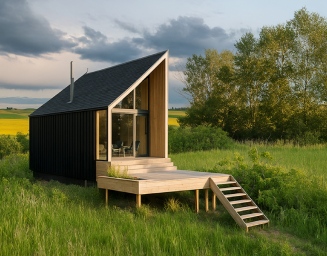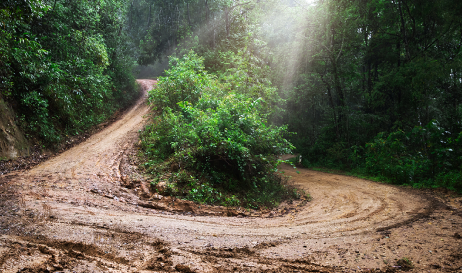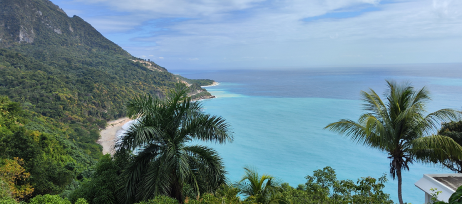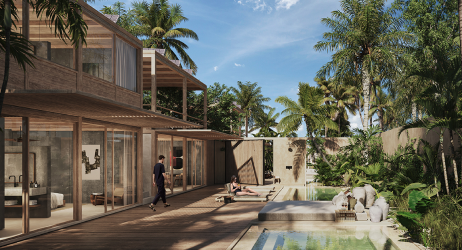24/07/2025 | SIAN
Discover the 10 criteria we recommend at SIAN for choosing land for a modular tourism project
At SIAN, we understand that investing in cabins, microresorts, holistic spaces, or ecolodges can be both exciting and challenging. It all starts with one key question: Where are you going to build it?
We believe that the true value of a piece of land lies not in what it is today, but in what it can become. We guide our clients to see beyond: to find beauty in the isolated, opportunity in the overlooked, and purpose where others only see unused land.
Because choosing the right plot is the foundation of everything. It's not just about aesthetics: you have to think about accessibility, regulations, orientation, connectivity, and much more. At SIAN, we design to preserve, not to destroy. To adapt to the surroundings, not to impose. That’s why we created this practical guide with 10 key points we consider every time we take the first step alongside our clients.
1. Choose a location that works today and grows tomorrow
It’s not just about how beautiful the place looks today. It’s about its future potential. At SIAN, we analyze each piece of land not only for its current appeal but for what it could represent in 3, 5, or 10 years.
Are you looking at an emerging tourist area? A hidden gem? Even the most remote plots can work with good planning. Today, there are efficient solutions for off-grid projects: solar panels, biodigesters, wells, and rainwater collection tanks. The key is to assess whether the land has the basic conditions to support the kind of experience you want to offer.
For example, we seek to collaborate with landowners who share a vision: to transform their land into a unique destination, without compromising the environment or facing the development process alone. That’s why, when evaluating a project’s viability, we consider key aspects that increase its potential for success:
• It is located at a reasonable distance (between 1 and 3 hours) from a city or tourist area with good connectivity
• It stands out for its authentic natural surroundings, open views, or a strong cultural identity
• It offers easy access, solid privacy, and is free from urban disturbances like noise or artificial lighting
• It is currently undeveloped or has the potential to evolve into a profitable project aligned with sustainability principles
According to Booking.com's Sustainable Travel Report, 44% of travelers plan to choose lesser-known destinations in the coming years, seeking nature connection and more authentic experiences.
2. Orientation: more light, less energy consumption
One of the first analyses we do before even sketching a plan is understanding how the sun and wind move across the land. Orientation changes everything: it improves indoor comfort, reduces air conditioning needs, supports natural ventilation, and enhances daylight use without consuming energy.
When the land is well oriented, we design the modules to work with nature. For instance, in warm climates, good orientation can reduce energy consumption by up to 30%, which impacts both your environmental footprint and your budget.
Whether it’s on a beach in the Dominican Republic or the highlands of Canada, efficiency starts with how the project is placed on the land.
3. Can the modules get there without issues?
It may seem obvious, but it’s not always the case. Many sites have narrow paths, sharp turns, or steep slopes that complicate module delivery. At SIAN, we solve this from the design phase: we don’t work with complete structures, but with modular pieces that travel in containers and are assembled onsite like Lego—quickly, precisely, and efficiently.
This gives us logistical flexibility and lets us reach places others can't. Still, we always check access conditions early on: roads, slopes, turning radii, and soil type. If improvements are needed—clearing paths, reinforcing terrain, prepping the entrance—we plan it from day one to ensure a smooth process.
In rural areas of Mexico or the Dominican Republic, improving access can represent 10–15% of total land preparation costs. Assessing it early avoids surprises and optimizes your total budget.
4. Topography: flat or sloped? Both work
Not all land is flat, and that’s a good thing. A well-used slope can completely transform the experience. It’s not about forcing nature, but integrating with it.
When the land is sloped, foundations can be adapted using stilts or elevated structures that reduce impact and help preserve the natural contours. This protects the ecosystem and, in many cases, results in spectacular views. The key is to plan properly from the start: what can be built, how to access it, and how the modules will connect. Studies show that sloped terrain can increase the perceived value of tourism accommodations by up to 20%, due to its visual connection with the landscape.
This same approach can even be applied to sites with bodies of water. Designing elevated spaces on stilts makes it possible to build over lagoons, rivers, or shallow coastal areas without disturbing the environment. It’s a solution that opens up unique, high-value opportunities for sustainable tourism developments.
Instead of seeing slopes or the presence of water as a problem, we should turn them into an advantage.
5. Soil studies: what you can’t see matters, too
Many projects run into trouble for ignoring what lies beneath. Before building, it’s crucial to understand the soil: is it rocky, sandy, or damp? Does it have good load-bearing capacity? Is there groundwater?
A geotechnical study is highly recommended, especially in coastal, tropical, or mountainous areas. This analysis helps determine what kind of foundations are needed, whether drainage or structural reinforcement is required, or if the design needs adaptation. It prevents costly mistakes and makes the process more predictable.
If you don’t know where to start, we’ll help you evaluate. The key is not to move forward blindly—the land speaks, and we need to listen. A soil study costs between USD 800 and USD 2,000, depending on the country, but it can prevent issues that would multiply costs later on.
6. Climate and natural risks: design with awareness
Every plot has its climate, and every climate brings specific challenges. Hurricanes, wildfires, landslides, or heavy rains must be considered when deciding on the type of cabins to build.
At SIAN, we design with that awareness from the start. Especially in places like the Dominican Republic, where over 60% of tourist areas are at cyclone risk, we work with solutions that meet high resistance standards for extreme climates.
Our modules are designed to adapt to their environment and offer safety. It’s not just about aesthetics or functionality; it’s about being prepared for what the site demands.
Safety and durability are non-negotiable. Designing with the climate, not against it, is one of the pillars of our approach.
7. Regulations and permits: Every place has its own rules
No two plots are the same, and neither are two municipalities, let alone two countries. From land use restrictions and height limits to environmental regulations or density criteria, every state, community, or land trust has its own guidelines.
That’s why, before drawing any plan, it’s essential to check with the technical team whether the plot is:
• Residential, tourism, or mixed use
• Allows modular or prefabricated construction
• What buildable area is permitted (COS and CUS)
• What permits are required: licenses, environmental impact, water use, etc.
According to The Center for Sustainable Building, over 40% of delays in tourism projects in LATAM are due to regulatory planning issues.
That’s why the design must adapt to local rules without losing the project’s essence. In areas like Quintana Roo, Baja California Sur, or California, we’ve managed processes that take 2 to 6 months—but with a clear plan from the beginning, everything flows better.


8. Does it have services, or will you need to provide them?
Many high-potential tourism plots are far from traditional water, electricity, or sewage networks. However, that’s no longer a problem: today, there are efficient and accessible solutions that allow for complete off-grid operation, without sacrificing comfort or design.
• Solar panels and backup batteries
• Rainwater collection and filtration
• Efficient well systems
• Biodigesters or next-gen composting toilets
• Satellite or rural 4G internet
• Passive ventilation and bioclimatic design to reduce energy use
According to the North American Sustainable Tourism Alliance, over 35% of new eco-developments in Mexico and Central America already use solar energy as a primary source. In the U.S., over 70% of luxury glamping in rural areas operate with hybrid autonomous systems.
Today, this is reality: off-grid plots can be turned into natural retreats, sustainable lodgings, or well-equipped microresorts. The key is planning properly.
9. Realistic budgeting and phased growth
Buying land is just the first step. You also need to factor in lot preparation, permits, access, services, and, of course, construction. That’s why having the support of a company like SIAN helps you plan your project in clear, realistic phases—without compromising on quality or long-term vision.
One of the great advantages of modular design is that it allows you to scale in an organized way: you can start with one or two units and expand as demand or resources grow. That way, you start generating returns before the full development is complete.
Models like "build-to-scale" or "expand as you grow" are becoming ideal strategies for microresorts, ecolodges, and boutique developments. Less risk, more flexibility.
10. Your vision is the core of it all
This is not just about building a structure. It’s about giving life to a meaningful space that reflects what you want to offer, and how you want people to feel when they inhabit it.
At SIAN, we don’t design from a closed catalog—we design with you. We listen to your idea, analyze the land, and build from there. Modular doesn’t mean limited—it means adaptable: to your style, your site, and the kind of experience you want to deliver—whether it’s a luxury microresort, a personal retreat, a holistic space, or a vacation rental investment.
73% of global travelers are looking for accommodations that reflect authenticity and connection with the local community (Booking.com Sustainable Travel Report). Authenticity can’t be improvised; it’s designed with intention.
With SIAN, your modular project isn’t a copy of others; it’s an extension of your vision.
Comments















